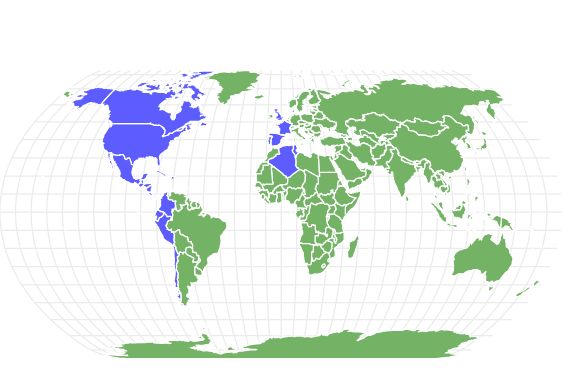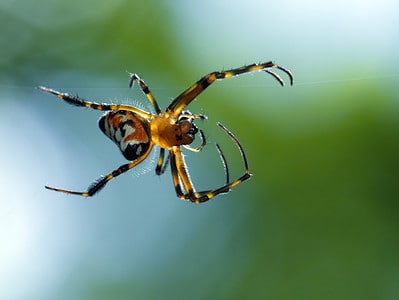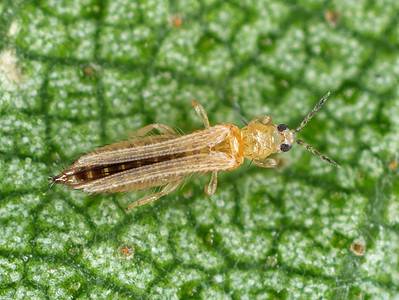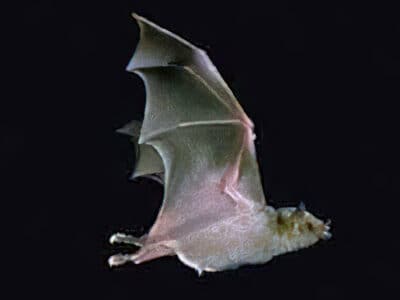Ruddy Duck
Oxyura jamaicensis
Ruddy duck breeding males have bright blue bills!
Advertisement
Ruddy Duck Scientific Classification
- Kingdom
- Animalia
- Phylum
- Chordata
- Class
- Aves
- Order
- Anseriformes
- Family
- Anatidae
- Genus
- Oxyura
- Scientific Name
- Oxyura jamaicensis
Read our Complete Guide to Classification of Animals.
Ruddy Duck Conservation Status
Ruddy Duck Facts
- Fun Fact
- Ruddy duck breeding males have bright blue bills!
- Wingspan
- 22.1 to 24.4 inches
- Incubation Period
- 20 to 26 days
- Diet
- Omnivore
View all of the Ruddy Duck images!
Ruddy Duck Summary
“Ruddy duck breeding males have bright blue bills!”
The ruddy duck is a species of diving duck found throughout several regions of the world. They are most common in the Western hemisphere, although small populations exist elsewhere in the world as well. You can best identify them by the breeding male’s coloration or their long, sharp tails that they hold upright. There have been fossils as old as 11,000 years found belonging to this species of duck.
Ruddy Duck Amazing Facts
- They lay the largest of all duck eggs relative to body size.
- They are native to the western hemisphere but have been introduced elsewhere.
- These ducks can be highly aggressive, especially during the breeding season.
- They often flock together with other diving ducks, such as the goldeneye.
Where to Find Ruddy Ducks
Ruddy ducks are native to the western hemisphere, including both North and South America. They live most abundantly in the United States, followed by Canada and Mexico. Year-round populations can be found in the western coastal countries of South America, such as Chile and Colombia. Other areas of residence include the islands of the Bahamas.
In both breeding and non-breeding seasons, ruddy ducks inhabit similar areas. They prefer wetland marshes, ponds, and lakes. They may also reside in brackish waters, such as estuaries.
There are also small, year-round populations located in Europe as well as along the northern coastal regions of Africa. These are the result of captive ducks escaping sometime in the 1950s. These have been regarded as invasive species in the United Kingdom due to the threat they pose to native species.
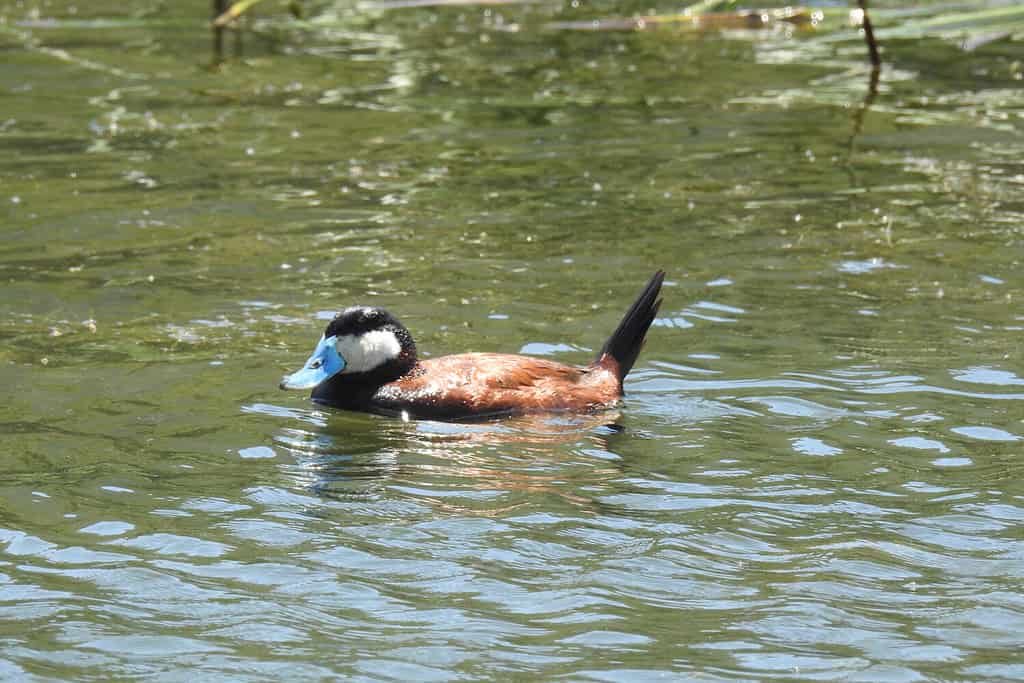
Ruddy ducks are most often found on or near freshwater and brackish water.
©Scenic Corner/Shutterstock.com
Ruddy Duck Nests
It is the female’s responsibility to choose a nesting location. These ducks will often choose to nest near or on the water, usually in the grasses or cattails located in the shallows. Dense vegetation offers concealment and protection.
The nest itself is constructed out of plant materials. Dry plant materials are the most common, but some nests have been made entirely out of fresh, still-green plants. The nest begins as a platform before a cup is formed. After the nest is complete, ruddy ducks will weave together plants to create a canopy.
Ruddy Duck Scientific Name
The scientific name for the ruddy duck is Oxyura jamaicensis. The genus name comes from the Ancient Greek words “oxus” (meaning sharp) and “oura” (meaning tail). Its species name, jamaicensis, translates to “from Jamaica”.
The ruddy duck is in the class Aves, along with all other bird species. It is in the order Anseriformes, which includes all waterfowl, and the family Anatidae.
Ruddy Duck Size, Appearance, and Behavior
The ruddy duck is a smaller species of duck with a compact build. Profile-wise, they are most recognizable by their long, uplifted tails and scoop-shaped bills. Adults of this species will grow to be between 13.8 and 16.9 inches long, and they can weigh 10.6 to 30.0 ounces. The average wingspan of this duck is between 22.1 and 24.4 inches.
Male and female individuals of this species can differ greatly in appearance.
Breeding males have a blue bill. Their bodies are overall a chestnut color, while their heads are black and white. The white marking on their face is just beneath the eye and takes up the majority of the face. The black marking appears like a cap, as it begins at the bottom of the eye and makes up the head and the back of the neck. Outside of the breeding season, adult males lose the blue color of their bill, instead sporting a grey to black bill. They also lose much of the coloration on their body, with the chestnut fading slightly and the black marking on top of their head fading to a grey or cool brown color.
Females and juvenile ducks lack the stark white, solid coloration on the face that adult males have. The top of their heads is a dark brown, while their bodies are mostly a buff brown coloration. The area around the face and neck is often lighter than the rest of the body, similar to the white marking on the male, but it is often less noticeable. Often, there is a blurred, brown stripe across the pale of the face. Some females may appear more chestnut than buff. Females and juveniles, like non-breeding males, have black bills.
This species of duck is mainly active at night, which is when they do the majority of their hunting. During the day, you can see them sleeping, often with their tails up and their heads tucked beneath their wings.
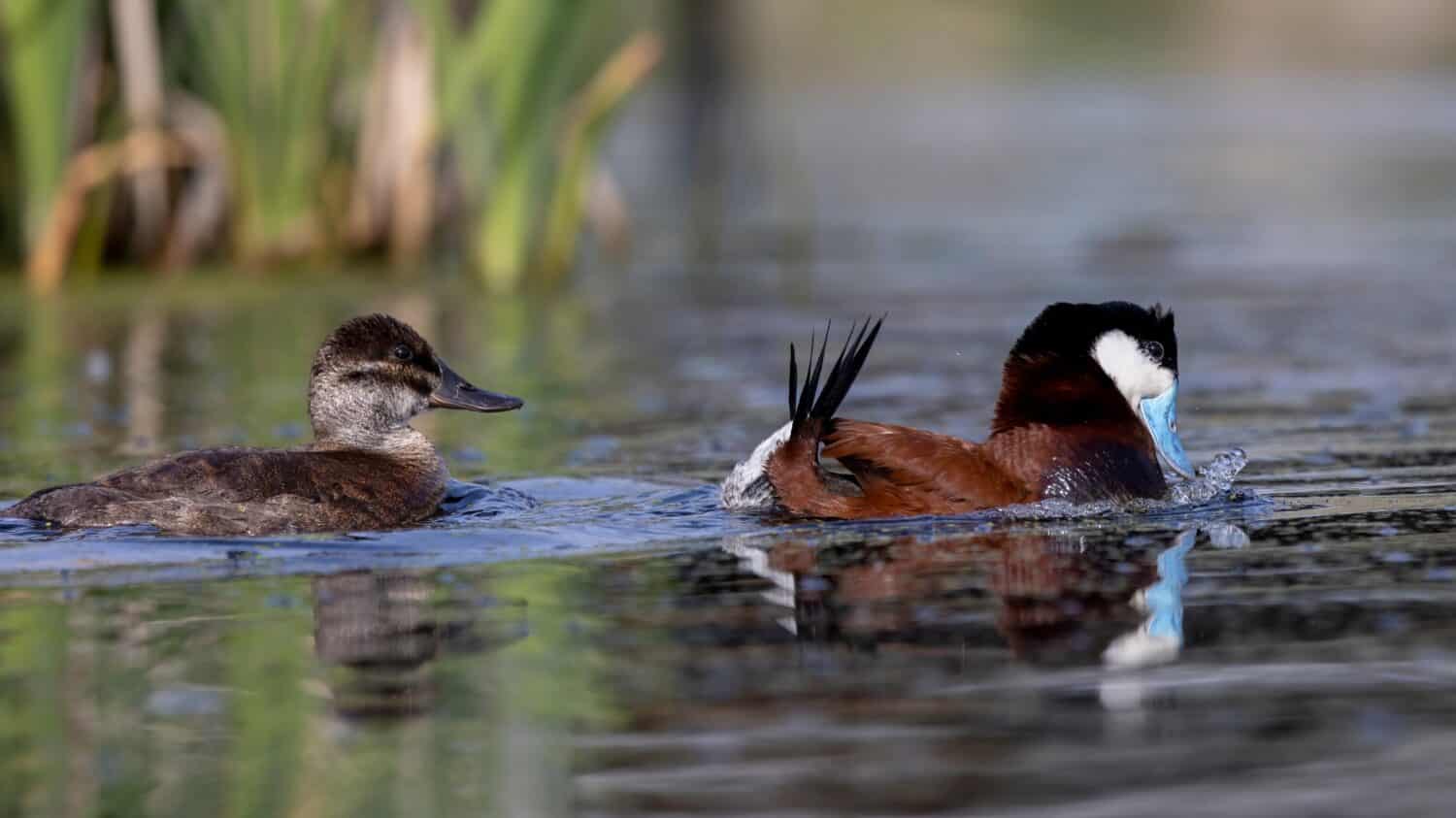
Female and male ruddy ducks differ in appearance, which is known as sexual dimorphism.
©Kendall Collett/Shutterstock.com
Ruddy Duck Migration Pattern and Timing
Although this species sports several year-round populations, there are also several migratory populations. Ruddy ducks are short-distance migrants that flock together in groups of 5 to 15 individuals.
They migrate during the night, wintering in Mexico, Central America, and the southern United States. They often breed in central-western regions of Canada and the United States, with migration spottings occurring in the east.
In California, breeding populations will migrate westward to the coast for breeding before returning to the east.
Ruddy Duck Diet
Both adult and young ducks of this species eat a variety of invertebrates, along with aquatic plants and their parts. This includes aquatic insects, crustaceans, and zooplankton, with midge larvae being one of their most abundant food choices.
As a species of diving duck, they dive under the water for their food. Their food of choice lives/grows along the lake or pond floor. As mentioned previously above, they perform the majority of their hunts during the night.
Plant matter is the most common part of their diet during migration and winter, with animal matter being primary during the breeding season.
What Do Ruddy Ducks Eat?
Ruddy ducks have a highly diverse diet. On average, they will consume the following:
- Midge larvae
- Water fleas
- Worms
- Seed shrimp
- Snails
- Caddisfly larvae
- Dragonfly nymphs
- Diving beetles
- Water boatmen
- Brine fly larvae
- Crane fly larvae
- Mosquitoes
- Mayflies
- Pondweed
- Musk grass
- Bulrushes
- Bayberry
- Spikerushes
- Water lilies
- Duckweed
Ruddy Duck Predators and Threats
Compared to other species of waterfowl, the ruddy duck faces few significant threats.
One of their main threats is hunters. Despite not being a popular game bird, ruddy ducks are hunted each year. In fact, tens of thousands are recorded annually. As a species of duck, this bird also faces the threat of pollution, especially oil spills and similar concerns.
Lastly, ruddy ducks also have natural threats in the form of predators.
What Eats Ruddy Ducks?
From hatchling to adulthood, ruddy ducks face a variety of different predators, including humans. Some of the most common predators of the ruddy duck include:
- Herons
- Gulls
- Mink
- Raccoons
- Foxes
- Snakes
- Hawks.
Ruddy Duck Reproduction, Babies, and Lifespan
Typically, males will take only one mate each year, although they may take more. Females will have one to two broods per year, each one with anywhere from 3 to 13 eggs on average.
As mentioned earlier, they have the largest eggs of all waterfowl by proportion. Each ruddy duck egg is up to 2.7 inches long and 1.9 inches wide. They are white, or off-white, in color with a pebbled texture.
The incubation period for ruddy ducks is 20 to 26 days. After this, the hatchlings will emerge well-developed with down. They are able to leave the nest after one day, although they will remain in the care of their parents for longer.
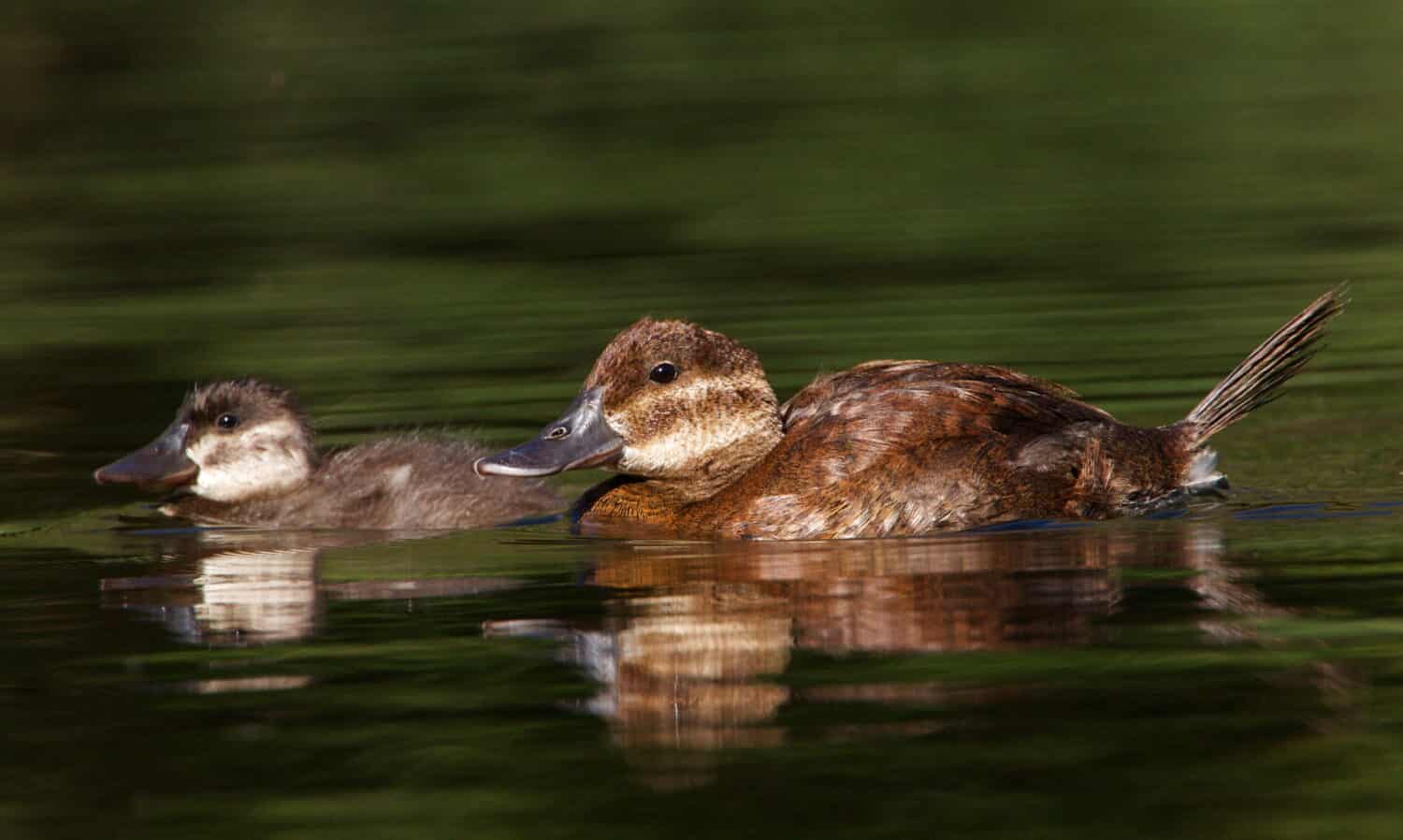
Young ruddy ducks (which resemble their mothers) can leave the nest shortly after hatching, though they stay with their parents for some time.
©Tom Reichner/Shutterstock.com
Ruddy Duck Population
The ruddy duck is considered a species of least concern. There are an estimated 1.3 million adult individuals, with little to no significant declines or inclines in recent decades. However, with water quality declines and loss of habitat, this could potentially change.
View all 114 animals that start with RRuddy Duck FAQs (Frequently Asked Questions)
Do ruddy ducks migrate?
Yes, certain populations of ruddy duck will migrate a short distance.
How many eggs do ruddy ducks lay?
Per brood, a ruddy duck may lay between 3 and 13 eggs.
How fast do ruddy ducks fly?
Ruddy ducks reach top speeds of 45 miles per hour.
What is the ruddy duck's wingspan?
The average wingspan of this duck is between 22.1 and 24.4 inches
When do ruddy ducks leave the nest?
Hatchlings can leave the nest after one day, though they remain in the care of their parents.
Thank you for reading! Have some feedback for us? Contact the AZ Animals editorial team.
Sources
- , Available here: https://britishbirds.co.uk/wp-content/uploads/article_files/V102/V102_N12/V102_N12_22_32.pdf

